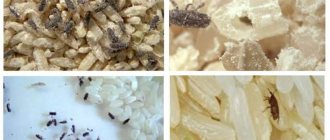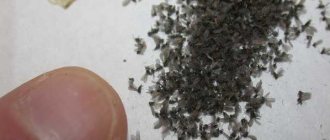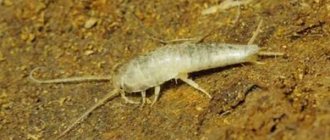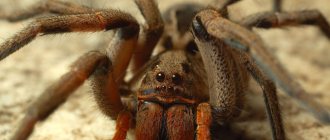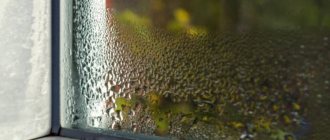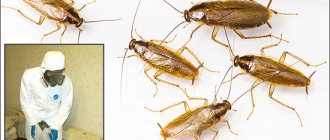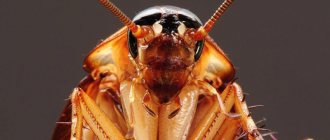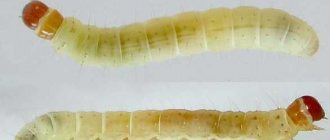Silverfish are insects from the bristletail order. Their genus includes only three species:
- Lepisma baetica
- Lepisma chlorosoma
- Lepisma saccharina
Lepisma saccharina, also known as the common, sugar, silverfish or simply silverfish, is the only species that is found in Russia; the other two live in the tropics. In nature, silverfish are busy processing organic matter, which they feed on, but sometimes they penetrate into rooms and remain there for a long time. What do they need in your home? Why and where do these insects come from? How to distinguish them from other similar pests and how to get rid of silverfish in an apartment?
Calculator
Calculate the cost of exterminating insects in the house
Number of rooms:
(Cold fog)
(Cold Fog + Barrier Defense)
(Hot fog + Premium drugs + Barrier protection)
(Hot fog + VIP drugs + Barrier protection)
Total cost: 01
Order processing
Sugar silverfish: description
If you think that you have a sugarfish in your apartment, a description of its appearance and habits along with a photo will help you be sure whether it is it.
What does it look like
- Lepisma saccharinum has a round, flattened, elongated body, gradually tapering from head to tail.
- The body length of an adult individual usually reaches 1 centimeter; in particularly favorable conditions, insects can be slightly larger.
- The body is covered with chitinous plates that overlap one another like armor.
- The color of silverfish, depending on the stage of development, can vary from white to dark gray with a metallic tint. The older the silverfish, the darker it is.
- The head is crowned with two long mustaches, often equal in length to the size of the body.
- In the caudal part there are soft cerci directed to the sides and a long caudal filament in the center.
- The insect has three pairs of legs.
How it moves
- Moves in jerks, alternating running with short stops.
- Due to the position of the legs, during movement the insect’s body bends and wags like a fish’s tail.
- Due to its physiological characteristics, silverfish can only run on horizontal and inclined surfaces; they are not capable of reliably clinging to a wall or ceiling with their paws.
- The silverfish quickly runs away if the light is suddenly turned on in the room where it is located.
How it lives and reproduces
- Silverfish larvae look exactly the same as adults, but are smaller in size - on average 0.5 millimeters or more, depending on the stage of development.
- The larvae are always lighter than adults; they can be white, pearl-colored, or silver.
- Over the course of her entire life, each female silverfish lays about 100 eggs.
- At temperatures around 22° C, the larvae hatch from the eggs after about 40 days, at temperatures close to 32° C - after 20 days.
- The sugar silverfish larva develops to adulthood in approximately 1 year.
- If the silverfish does not die for reasons beyond its control, it can live up to 8 years.
- At temperatures of +5° C and below, Lepisma saccharinum can go into suspended animation and survive in this state without food for 9–12 months.
- Silverfish can molt up to 60–70 times in their lifetime, including as adults up to the age of 4 years.
Silverfish are sometimes confused with woodlice and two-tailed fish. Woodlice are rounder and have 7 pairs of legs, not 3, double-tailed ones are darker and larger, their cerci in the tail are harder, the insect can use them as a weapon, lifting them up and spreading them to the sides. Silverfish are not aggressive and always prefer to hide from any threat, exposure to sunlight and electric light.
External description of silverfish
To understand what the article is about and to notice the insect in time, you need to familiarize yourself with its external description.
The body length of silverfish individuals that have reached sexual maturity reaches almost two centimeters (excluding whiskers). Throughout their life cycle, the size of silverfish can sometimes vary from 0.9 to 1.3 centimeters. After all, these insects grow in length throughout their lives. The insect's body is very flat and gradually tapers towards the tail. It also has a barely noticeable division into segments and is covered with a scaly layer, the color of which changes during periods of molting. The head of the silverfish is poorly defined, and the chest is quite wide.
Very often in nature there are two types of this insect: common and sugar silverfish.
The body of the pest may have the following shades:
- from dark brown to black,
- light brown or dirty yellow (typical of young silverfish),
- off-white (quite rare),
- with a silvery cold tint.
As noted above, silverfish have long and thick whiskers that point forward and at the end slightly diverge to the side.
A distinctive feature of this pest is the three processes present on the tail. They look like insect antennae. Silverfish also have three pairs of short limbs. Their eyes are complex and consist of faceted elements.
Causes of silverfish in the apartment
Silverfish can get into an apartment:
- Do it yourself, using ventilation shafts, grooves and cracks in communication wiring, cracks around windows and thresholds.
- Accidentally end up in packaging, bags or purchased goods.
- Cling to clothes, shoes, or get into your bag if you are in the place where they live for a long time.
- Arrive on pet fur after a walk or trip to the country.
- Live on houseplants and get into the house with a new potted flower.
If silverfish crawl on their own, then, as a rule, they live either in the nearest basement, or with neighbors, or on the street. In nature, Lepisma saccharinum lives under fallen leaves, stones, and in cracks in stone and cement masonry. In search of food in the summer, insects may well crawl into rooms, especially on the first few floors of a building.
The reasons for the occurrence of silverfish in an apartment cannot always be determined for certain, but this is not critically necessary information for pest control. What is much more important is why insects remain once they get into the apartment. For a comfortable life, they need a special environment and combination of conditions. For silverfish it is:
- Warm, optimally in the range of 22–27° C.
- High humidity – from 75% and above.
- Darkness.
- Secluded places, areas, crevices where you can hide.
- Water and suitable food.
The diet of silverfish includes foods rich in carbohydrates, in particular polysaccharides. In residential areas, silverfish can eat:
- Millet, oats, rye, barley
- Lentils, mung beans, peas, chickpeas
- Hair, exfoliated skin particles, dandruff
- Sugar and products containing it
- Paper, photographs, plaster
- Fibers of fabrics, clothing, interior items
- Remains of dead insects
- Chitinous coverings shed during molting
- Microorganisms growing in moist environments
- Decaying green houseplants
In search of food, silverfish are able to travel distances that are quite large for their body size, although they still try to somehow optimize their movements and, if possible, reduce their distance. Most often, silverfish can be found in an apartment in the bathroom, shower, toilet or kitchen. They can also be in rooms, but somewhere nearby there must be a dark, warm and secluded place with a high level of humidity. A crack next to a leaking battery or a flower pot with constantly waterlogged soil on the windowsill would be perfect for its role.
Who are silverfish and why do they appear in our homes?
Sometimes the first meeting with a silverfish can cause sincere surprise, since it is almost impossible to take these small and nimble insects by surprise during daylight hours. An elegant elongated body, shaped like a droplet or a small flat fish, slightly thickened in front, with tiny antennae and many legs, these are the distinctive features of this nocturnal creature, which prefers to live in bathrooms, kitchens, basements and toilets.
silverfish are a frequent visitor to apartments and houses with high humidity levels
Typically, these insects prefer to run exclusively on the floor, which is due to an attempt to get food. The main source of food for them is paper, fabrics, mold and mildew, which are typical for rooms with high levels of humidity, as well as starch, food debris, sweets, and glue, which is why they can cause significant damage to your home. A large number of multiplying silverfish can cause significant damage to your library, as well as archives with family photographs. They can also ruin your wardrobe and wallpaper, leaving small holes on them that resemble perforations.
silverfish can cause significant damage to your home library
In most cases, silverfish willingly move into rooms with obvious microclimate disturbances. The optimal conditions for them are a humid environment (from 75%), as well as the presence of heat (from 23 C) and a sufficient amount of food. These small creatures most often make their way into apartments through ventilation pipes, open windows, and cracks in the walls. However, sometimes you can accidentally bring silverfish into your home on your own, along with paper products, packaging materials, things from the basement, library books, and building materials.
The favorite habitats of silverfish in houses are:
- Bathroom, toilet and laundry room,
- Home library,
- Kitchen,
- Pantry,
- Basement.
You can notice the appearance of these uninvited guests in your apartment by traces of damage to property, as well as by accidentally discovering their droppings, which may end up on the table, dishes, and also in bulk food products. Outwardly, it resembles grains of black pepper. This insect can lay its eggs anywhere, however, it is very difficult to notice them.
Danger to humans
There is no direct threat from silverfish to humans, since they do not bite and do not carry pathogens of various diseases. But silverfish can cause other damage if there are quite a lot of them.
When there are a lot of them, you can expect the following actions from silverfish:
- These insects are considered the main enemies of archives and libraries . Silverfish produce a special enzyme that converts paper into nutrients. These pests can ruin the remains of wallpaper, various books or documents, which leads to the loss of necessary information.
- Numerous insects . Some females are capable of laying up to 200 eggs, and after a couple of weeks the same number again. When young individuals grow up, they will be able to lay the same number of eggs as their parents. As a rule, when there is a concentration of various insects in a home, this leads to panic and discomfort. In this case, it is better to forget about normal living conditions.
- Lots of waste . One can only imagine how much waste entire colonies of silverfish leave behind. In addition, their feces can easily end up in food, which is completely undesirable, and who would want to eat such products.
- The omnivorous nature of these insects . Silverfish can eat anything. They will eat wallpaper, even if it has glue, not to mention products made from linen, cotton or viscose.
Therefore, it is unlikely that any of the owners will desire such a neighborhood. If pests are found, then you need to immediately begin to destroy them.
Are silverfish dangerous for humans?
Silverfish:
- Don't bite
- Don't drink blood
- Are not carriers of diseases
However, like any other insects, silverfish live in contaminated places - sewers, ventilation, soil and come into contact with decaying organic matter. Their bodies, shed chitinous coverings, and excrement may contain harmful bacteria that can cause a local allergic reaction on the skin upon contact and lead to gastrointestinal problems if you eat foods that the silverfish have eaten.
Whether silverfish are dangerous to humans, things and objects in the house largely depends on their numbers. The more insects, the more often they come into view and the more abundant the amount of dirt from them. In addition, a large number of pests require more food, and damage to fabrics, clothes and objects can become noticeable. In order not to bring the situation to a critical scale, you need to start destroying pests as soon as you notice them. The sooner you start doing this, the easier and faster you will be able to get rid of insects.
Features of the life of silverfish
Silverfish are typically nocturnal.
During the day, they hide in secluded places or search for a place to lay their ovipositor. Most representatives of this species live in human habitation, and some live in the wild. Those that live in the natural environment feed on mushrooms, moss, algae and humus, and hide under stumps or fallen leaves. The most common type of silverfish is the common silverfish, which is also called sugar silverfish. She acquired this name because of her love for sweets. The thing is that representatives of this species need nutrients: glucose and starch.
Of course, silverfish can eat almost anything, but they have their own taste preferences:
- Sugar, potato and wheat flour, vegetables and fruits. The insect does not eat cereals, but lays its eggs in them, since this place seems safe for silverfish.
- Silverfish also eat cellulose and plastic, which, for example, are contained in books and bags. In addition, the pest can feed on textiles, wool and leather.
- Silverfish can also eat finishing materials, as well as furniture fillings. For example, wood, old wallpaper, foam rubber, and so on.
Despite the fact that this insect has a large appetite, it can live without food for a little less than a year.
The main condition for the life of silverfish is high humidity. That is why the insect often lives in bathrooms. Any crack or crevice in the floor or wall can be a home for silverfish. In addition, it settles under old wallpaper, in garbage or human food. Due to the fact that the insect does not like light at all, it is almost impossible to see it during the day. After all, silverfish move only in dark areas of the room.
The insect itself does not need water. Moreover, it is very dangerous for silverfish, because these pests cannot swim and drown when they get into water.
While in nature, silverfish travel long distances. Interestingly, she moves very quickly. All its life the insect is busy reproducing. Females of this species do not mate with males, but search for spermatophores left by males in random places.
At one time, a female can lay up to 60-70 eggs. Almost all of them turn into larvae and survive.
Silverfish
- these are those insects for which molting is very important. Its larvae change their appearance quite often, because the number of molts during the entire life cycle of silverfish is always different.
Silverfish: how to get rid of an apartment - effective ways
To get rid of silverfish completely and permanently, it is necessary to combine preventive measures with extermination measures. In general, your pest control plan should look like this:
- Determine where pests accumulate and live by observing them and inspecting areas with a suitable environment.
- Change the microclimate in the apartment so that it becomes unsuitable for pests - first of all, reduce the humidity level.
- Carry out massive baiting of silverfish using selected means and methods.
- Isolate the house as much as possible from the penetration of insects by eliminating minor damage in the apartment and cosmetic or major repairs.
The last step is relevant in the prevention and control of any type of pests, therefore, by using the recommendations from this category, you will protect your home not only from silverfish, but also from much more harmful and dangerous insects that can encroach on it. What exactly is silverfish afraid of, how to get rid of it in an apartment, and what effective methods exist for this?
Chemical destruction of silverfish
If setting traps is not suitable for you, then you can use special chemicals to combat silverfish.
1. One of the most common means of removing insects is diatomaceous earth. Before going to bed, scatter it in places where you most often notice silverfish, and vacuum it up in the morning.
2. Another fairly effective remedy to quickly get rid of annoying silverfish is boric acid.
3. Pyrethrin-based insecticidal sprays help fight many insects, including silverfish. Cannot be used in areas where food is found and should be kept away from children and animals.
Using the above products, it is necessary to treat baseboards, cracks and other places where there are accumulations of insects.
4. Zest shavings can serve as a means of repelling silverfish by smell, however, it is worth noting that there is no talk of killing insects. It is not comfortable to constantly keep scattered powder in the apartment, so this method is only suitable for rooms where order is not so important, for example, basements and warehouses.
5. Another way to get rid of silverfish in the kitchen is to scare them away with a set of strong-smelling spices, placing them in cabinets. The spices of sage, cinnamon, bay leaf and others are quite suitable.
6. And finally, the last remedy that will make silverfish leave your bathroom is a citrus smell. You just need to buy a little lemon or lavender essential oil, dilute it in water and spray it on the places where insects have been noticed. This method is best suited to closed boxes and small, rarely used rooms - there the smell will not dissipate for a long time and will save you from pests, and it will also pleasantly delight you with freshness.
Regulation of humidity, heat and microclimate
Reducing humidity and adjusting temperature is necessary no matter what method of pest control you choose. A special device for measuring humidity levels will help you track accurate indicators - a hygrometer or thermohygrometer, which, along with humidity, also shows temperature. You can reduce humidity by:
- Air dryer installations
- heater
- Heated towel rail
- Frequent ventilation
The level of humidity in the bathroom is greatly influenced by the state of ventilation, so if there is excess condensation, it is necessary to clean it first.
Folk and chemical remedies for insects in the bathroom
There are many methods to combat them, such as physical ones. The physical method of control is the creation of certain conditions that will be destructive to insects. Of course, these methods are only emergency assistance, and it is not enough. Because from the remaining eggs a new generation of pests will emerge. To get rid of them, you can use one of the methods described below. We recommend starting with folk remedies, as they are less dangerous. Especially if there are few insects. Don't intend to experiment? Then use household chemicals.
Folk, improvised, natural remedies
Cedar oil
Cedar oil repels but does not kill silverfish. You can soak cotton pads in oil and place them in places where you often see insects, or prepare a mixture of 500 milliliters of water and 10-15 drops of oil, which you then spray on surfaces.
Helpful advice
Silverfish do not like the smell of any coniferous plants, so to repel them, you can use bags of fresh spruce and pine needles, as well as sawdust for rodents and wood fillers for cat litter made from coniferous wood.
Place pine needles, sawdust or pellets in areas where you often see pests. Sawdust and granules need to be changed once a week; bags of pine needles can be left for a year. Cinnamon
The smell of cinnamon repels silverfish. A suitable source is cinnamon sticks, powder or oil, which is mixed with water in a spray bottle and applied to surfaces where silverfish run.
Citrus
Oranges, lemons and other citrus fruits help repel silverfish, especially when fresh when the smell is most intense. You can use both skins and pulp. Once a week, replace dried cuttings with fresh ones so that the intensity of the smell does not decrease. You can make a surface treatment spray from lemon juice and water.
Carefully!
Lemon juice can lighten fabrics and surfaces.
Before applying it to any material, test the solution on an inconspicuous area or, if in doubt, choose an alternative method. Cucumber skins
Cucumber peels affect silverfish in a similar way to citrus and are used in the same way.
Bay leaves
Dried bay leaves help repel pests. They are especially convenient to use in kitchen cabinets.
Carnation
When fighting silverfish, cloves as a spice are suitable. The inflorescences must be placed in places where insects are found in the apartment. Cloves can also be used in the form of oil, soaking cotton pads in it or preparing a spray with it, however, the smell of cloves is very concentrated. Before you apply it to anything in your home, make sure you like it. It will be difficult to remove it from surfaces and objects.
Why use silverfish repellents?
Repellents are essentially absolutely useless in the fight against most types of pests, but in the case of silverfish, it makes sense to use them.
With their help, you can scare away pests from products and objects that they can spoil. To do this, you need to lay out and apply all repellents close to the places and things that you want to protect from insects. For example, in cupboards with cereals, in a drawer with dirty things in the bathroom, in closets with clothes, etc. Salt
The integument of the silverfish's body is quite thin, so any contact with salt can cause harm to the insect, even death. You can sprinkle salt directly on insects, or in places where you often see them. Leave the salt for a week, then vacuum it up. Repeat the procedure several times, tracking changes.
Diatomite
Diatomaceous earth, diatomaceous earth or diatomaceous earth acts on insects in the same way as salt, but works faster and more intensely. Diatomaceous earth must be scattered in areas where silverfish live. When contacting it, pests will die from dehydration.
note
Diatomite works only in a dry state.
It is advisable to scatter the powder in places where there is no strong draft, otherwise it will scatter throughout the apartment. Boric acid
From boric acid powder and starch-containing products, you can make food baits for silverfish and place them in small portions on substrates in places where the insects live. Mix boric acid powder with food bait in a 1/1 ratio. Suitable attractants with a high starch content are:
- Corn grains
- Rice
- Beans
- Potato
- Bananas
Food and acid must be mixed until smooth before use.
Carefully!
Place food baits only where pets and small children cannot reach them, or choose alternative baiting methods.
Baits with boric acid, if they enter the gastrointestinal tract, are equally dangerous for people, animals, and insects. Household cleaning products
Any household cleaning products, especially those based on chlorine, can destroy the integument of silverfish. Use them regularly to clean the bathroom, bathroom fixtures, and tiles.
Ways to fight
In order to prevent cohabitation with such unpleasant neighbors, you need to take radical measures. The control strategy consists of setting traps, chemical and mechanical methods.
The latter includes frequent ventilation of damp rooms, and thorough cleaning with a powerful vacuum cleaner of those places where silverfish can settle.
You shouldn't leave food for them. This means that you need to store things and products in hermetically sealed containers - jars, bags, boxes, containers.
Physical methods
There are different ways to combat silverfish.
To prevent silverfish from living in the bathroom, it is necessary to reduce the humidity. You should carefully inspect the pipes to identify leaks and repair them.
All rooms where insects were previously identified should be thoroughly cleaned and treated with bleach. After the walls and floors have dried, they must be coated with a solution of copper sulfate. This will destroy the silverfish eggs. You should open the bathroom so that the air in it becomes drier. It is advisable to install a forced ventilation system.
All rugs, towels and other things that were in the bathroom must be washed and dried in the sun. It is recommended to throw away items that are very damp.
Cold treatment of the apartment
Silverfish do not like the cold. In winter, when it’s cold outside, ventilating the apartment, in particular the bathroom, helps a lot. Open all doors and windows for ventilation for several hours.
If the room temperature is less than 10 degrees, the insects will die. This measure is more suitable for a dacha and country house, but can also be used in an apartment.
Folk remedies
Red pepper and tobacco help to quickly remove silverfish. To prepare the composition you need to mix 5 tsp. soda, 1 tsp. tobacco and 1 tsp. ground red pepper. The mixture must be diluted with 1 liter of warm water. The resulting product is used to treat the walls and floor of the bathroom. After this, you need to rinse the surfaces with water and bleach and ventilate the room well.
You can fight these insects with boric acid. The product is sold in powder form. Up to 25 g of this substance dissolves in 1 liter of warm water. The resulting mixture is used to treat areas under the bathtub and sink. The room is ventilated after the procedure.
You can use salt to repel silverfish. It is scattered in paths under the baseboards in the bathroom and toilet.
In addition, it is recommended to regularly wash floors, walls, furniture and bathroom fixtures with water containing citrus and lavender essential oils. This helps repel silverfish.
With the help of alum
- To combat these little pests, measure out 500 ml of boiling water.
- Dissolve 100 g of alum in it.
- Pour the resulting solution into a spray bottle.
- Spray the mixture in areas where silverfish are most concentrated. This will eliminate a large number of these little intruders. If necessary, the procedure should be repeated several times.
Insecticides
Insecticides in the form of aerosols, sprays and concentrates are suitable for treating silverfish habitats, for example, such as:
- August Cucaracha Spray
- Concentrate Medilis-Super
- Aerosol Clean House from skin beetles
- Raid Max aerosol
- Combat SuperSpray
Using any glue-based insect traps on substrates is also effective. They will need to be changed periodically as they become dirty.

